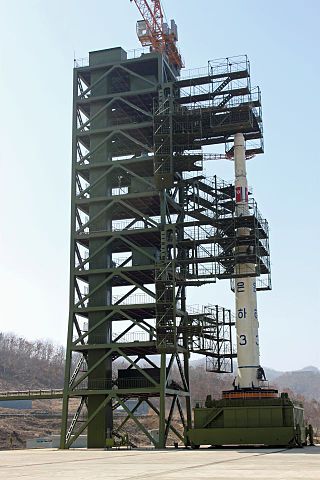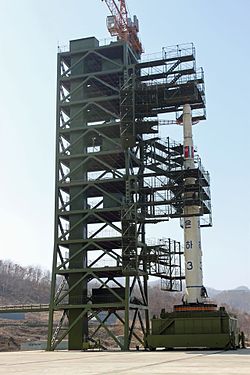Top Qs
Timeline
Chat
Perspective
Unha
North Korean expendable carrier rocket From Wikipedia, the free encyclopedia
Remove ads
The Unha[a] (Korean: 은하; lit. Galaxy) is a North Korean expendable carrier rocket, which partially utilizes the same delivery system as the Taepodong-2 orbital launch system.
Remove ads
Description

The Unha's first stage consists of four clustered Nodong motors, which themselves are enlarged Scud motors. The second stage was initially thought to be based on the SS-N-6, although it, too, is now believed to be based on Scud technology. The third and last stage might be identical to the Iranian Safir's second stage which is propelled by two small gimballed motors.[4][6]
Recent satellite images of the Sohae Satellite Launching Station showing an enlarged launch tower under construction have prompted online speculation that an enlarged version, called "Unha-X", might be under development.[7]
Remove ads
History
Summarize
Perspective
First space launch attempt of North Korea
North Korea's first orbital space launch attempt occurred on 31 August 1998, and was unsuccessful. This launch attempt was performed by a Paektusan-1 rocket, which used a Hwasong-7-based first stage, a Hwasong-6-based second stage and a solid-fueled third stage. The Paektusan-1 was estimated to be about 24 metres (79 ft) long, have a mass of about 21,000 kg (46,000 lb) and a first stage diameter of 1.25 m (4.1 ft).[8]
Launch history of Unha
First launch attempt
On 24 February 2009, North Korea announced the plan to launch the Kwangmyŏngsŏng-2 satellite onboard the Unha-2 launch vehicle.[9] Later, North Korea confirmed that the launch would take place between 4-8 April 2009.[10] However, before the launch, several countries, including South Korea, the U.S., and Japan, voiced concerns that the launch would violate United Nations Security Council Resolution 1718 which prohibits North Korea from testing ballistic missiles.[11] Russia also announced they urged North Korea to refrain from its planned rocket launch.[12]
On 5 April 2009, the Unha-2 rocket was launched at around 02:30 a.m. UTC (11:30 a.m. local time) from the Tonghae Satellite Launching Ground (also known as Musudan-ri).[13] The U.S. Northern Command said that the first stage of the rocket fell into the Sea of Japan (East Sea of Korea), while the other rocket stages as well as the payload fell into the Pacific Ocean, and no object entered orbit.[14][15] Later analysis indicated the rocket impacted 3,850 km (2,390 mi) from the launch site, and that the second stage operated normally but the rocket's third stage failed to separate properly.[16] North Korea maintains that the rocket successfully put its payload in orbit.[17]
Second launch attempt
On 13 April 2012, North Korea launched the Kwangmyŏngsŏng-3 satellite onboard an Unha-3 rocket from the Sohae Satellite Launching Station, but it ended in failure.[18]
Third launch attempt
After the failure of the April 2012 launch, North Korea announced that the launch of the second version of the Kwangmyŏngsŏng-3 satellite would occur between 10 and 22 December 2012.[19] Later, the launch window was extended to 29 December 2012, as the Unha-3 launch vehicle suffered a "technical deficiency".[20] The launch took place at 00:49 a.m. UTC, 12 December 2012, as an Unha-3 rocket was launched from Sohae.[21] The Japanese government believed the rocket separated into three parts, landed in the sea off the Korean Peninsula, the East China Sea and the Philippine Sea, respectively. North Korea claimed that the satellite successfully entered orbit, while according to North American Aerospace Defense Command, the rocket deployed an object that appears to have achieved orbit.[22]
Fourth launch attempt
On 7 February 2016, North Korea launched another Unha rocket from Sohae. Officially dubbed Kwangmyongsong, it successfully inserted the Kwangmyŏngsŏng-4 satellite into orbit.[23]
Remove ads
List of launches
See also
Notes
- Also romanized from Korean script as Eunha under South Korea's Revised Romanization.
References
External links
Wikiwand - on
Seamless Wikipedia browsing. On steroids.
Remove ads

